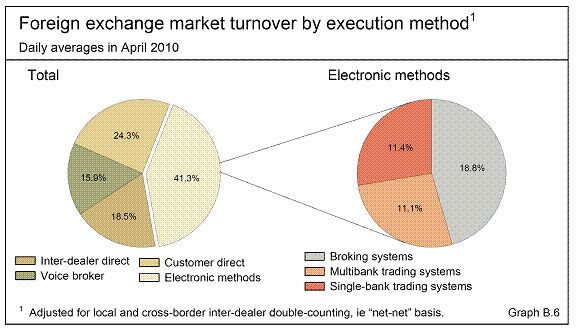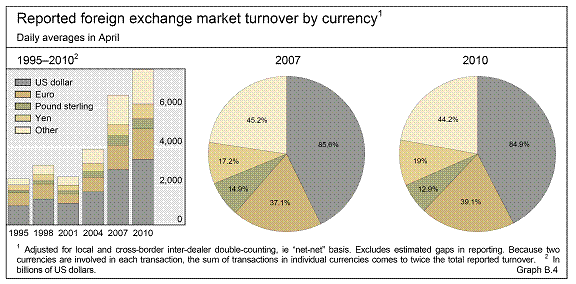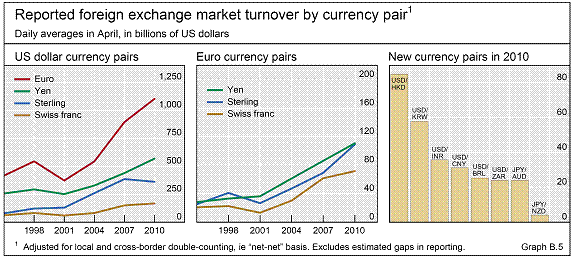The results from the triennial BIS forex survey are out. Unsurprisingly, trading volume continues to rise, the dollar retains its dominance in forex transactions, and the dollar/euro currency pair is the most heavily traded. But, notably, algorithmic trading is on the rise.
To me, the most interesting trend is the increasing importance of trading on electronic systems, as opposed to execution by other means.

Source: BIS, Triennial Central Bank Survey: Report on global foreign exchange market activity in 2010 (Basel, December 2010).
In a BIS Quarterly Review article, Michael King and Dagfinn Rime have observed:
An important structural change enabling increased FX trading by these
customers is the spread of electronic execution methods. Electronic trading
and electronic brokering are transforming FX markets by reducing transaction
costs and increasing market liquidity. These changes, in turn, are encouraging
greater participation across different customer types.
Continued investment in electronic execution methods has paved the way
for the growth of algorithmic trading. In algorithmic trading, investors connect
their computers directly with trading systems known as electronic
communication networks (ECNs). Examples of ECNs in FX markets are
electronic broking systems (such as EBS and Thomson Reuters Matching),
multi-bank trading systems (such as Currenex, FXall and Hotspot FX) and
single-bank trading systems. A computer algorithm then monitors price quotes
collected from different ECNs and places orders without human intervention
(Chaboud et al (2009)). High-frequency trading (HFT) is one algorithmic
strategy that profits from incremental price movements with frequent, small
trades executed in milliseconds.
See also their VoxEU post.
In a 2001 paper, Yin-Wong Cheung and I documented the early and rapid transition to electronic platforms, from 2% to about half going from 1993 to 1998. Since the samples are not comparable, we can’t say what has happened going from 1998 to 2010.
The issue of algorithmic trading is of interest to me, if only because we haven’t completely figured out the origins of the May 2010 “flash crash” in the equity markets. [1]

Source: M. King and D. Rime, “The $4 trillion question: what explains FX growth since the 2007 survey?” BIS Quarterly Review, December 2010. (Basel, December 2010).
King and Rime attribute a large share of the growth in trading volume (particularly in spot transactions) to high frequency trading (closely linked to algorithmic based trading):
The growth in electronic execution methods in FX markets has enabled
algorithmic trading. Algorithmic trading is an umbrella term that captures any
automated trades where a computer algorithm determines the order
submission strategy.13 For example, FX dealers use algorithms to
automatically hedge risk in their inventories or to clear positions in an efficient
manner. Customers are increasingly using execution management systems
that break up trades and seek the best market liquidity to reduce market
impact. Hedge funds and proprietary trading desks use algorithms to engage in
macro bets, statistical arbitrage or other forms of technical trading. All these
activities are contributing to the increase in FX turnover.
…
Market estimates suggest HFT accounts for around 25% of spot FX
activity. While many commentators suggest much of the growth in spot turnover
is due to HFT, the contribution of HFT to the increased FX turnover between
2007 and 2010 is not known with precision (Hughes (2010), Lambert (2010)).
Neither the Triennial data on counterparty types nor the data on execution
methods identify HFT. This estimate therefore cannot be verified.
More discussion in M. King and D. Rime, The $4 trillion question: what explains FX growth since the 2007 survey?” BIS Quarterly Review, December 2010. (Basel, December 2010). For me, one interesting question is whether this will make the forex market more volatile (at high frequencies). One study (cited in King-Rime) says no.
[Update, 8:44am Pacific] On a side note, my paper with Michael Moore (Queen’s U. Belfast) incorporating order flow data into a macro model of exchange rates will be presented at this week’s AEA meetings.


Interesting. Any more that you could add on risk v. efficiency considerations would be welcome.
Menzie,
I agree. When FOREX is traded like stocks they are succeptible to the same pressures. This could be devastating for a currency.
But what is amusing is that this risk is totally unnecessary. If currencies were linked, especially if that link was to something “as good as gold”, there would be no volitility in FOREX markets and there would be no risk of a currency crashing.
FOREX markets have been created by floating currencies, and are actually artificial markets trading in imaginary units. When the imagination of the traders sees a crash, the crash may be worse than anything we can imagine.
But I actually welcome the electronic trading because it increases the risk of floating currencies and makes the monetary disaster more likely. And such a disaster will bring back hard currencies very quickly. I just hope I am not in all cash when it happens.
The algorythms are readers of prices information,readers of prices convexity,unable to detect real inflexion point or prices crash.Few examples to sustain this allegation:
Cause of the called flash crash remain to be found.
Subprime crisis started when four banks only were left trading among each others (24 std downfall,a large hedge profit for some and a bitter zero sum effect for others)
Beyond the mechanization of forex trading there are gaps to be filled:
What portion of the real economy requirements are these forex dealings covering (World GDP ~45 trillion $,financial debts hold by foreigners? foreigners exposure to equities markets? Interest rates swaps? direct investments abroad?interest swaps?)
3.981 trillion usd daily turnover in April 2010, 1998 1,527 trillion usd (as the euro members were growing, the needs for currencies hedges were commensurate on short term currencies dealings?)
http://www.bis.org/publ/rpfxf10t.pdf
Outstanding questions:
How economic data, feeding the information for prices are read,when economists are hardly finding a consensus on the same topic ?
How to explain that most of the transactions in the forex are made between banks leaving to the non financial institution a very modest share of the forex transaction requirements (P9 BIS report)
Are the banks contingent liabilities so immune,to conterparty bankruptcy?
To be read the FDIC Ceo thoughts and recommendations on the subject:
Bloomberg
Banks Best Basel as Regulators Dilute or Delay Capital Rules
“Bair, 56, is one of five U.S. representatives on the board. She has assailed bankers for exaggerating the impact of planned regulations in an effort to scare the public and politicians. In an interview in June, she questioned “whether regulators can place any reliance on industry analysis of the impact of proposals to strengthen capital rules.”
Banks accounts are certified,banks Ceos do go back home everyday knowing the risk content of their balance sheets and contingent liabilities risks,Value at Risk have proved to be operative safeguards.
How much profits are drawn by banks from speculative forex activities ?
Fascinating – Professor Chinn presents some great data on a topic that actually matters – i.e. no knee jerk liberalism – and almost no one reponds.
A couple of empirical comments about FX trading. If you see both sides of, say Cable, in massive volume as on the JP Morgan trading floor in London, you start with a big advantage. Throw in the fact that S-T FX exhibits trending – serial correlation – and you usually have a house advantage. This should not be one of a huge bank’s big trading risk areas.
Since FX exchange rates among multiple currencies bear a mathematical relationship in any particular configuration that results from fundamental economic relationships, any deviation of one or another currency — for whatever reason — sets of a recalibration jitter.
It isn’t surprising that a properly programmed computer would be able to initiate risk-free arbitrage trades in response to doubtless frequent “jitters” injected into the FX market by unsophisticated speculators and sophisticated speculators who are just wrong about fundamentals.
David L. Kendall,
You would fit right in at Long Term Capital Management. You should apply for a job. What? Long Term Capital Management failed….? Never mind.
I read that soome HFT systems are able to sniff order data passing through network before the these information reaches destinations and shows up on the screen. These HFT those keep tracks of the pulses of ordering data and be able to frontrun most orders if certain criteria are met.
anon,
You are correct about these computer programs by some brokers, but the impact of these computer programs has no effect on the total economy.
What happens is that a sale is input at one price and a buy at another. The computer program then allows another firm, with access to the information, to inject a buy above the sell price but below the current buy price then sell at the current buy price.
While this is parasitic and takes gain away from the seller, the seller is satisfied because the sale is actually more than the contrated price and the buyer does buy at the price anticipated. So even though the “parasite” sucks away profit everyone is satisfied.
Consider that most of such transactions are between the larger firms who usually know what is going on so most of these trades simply redistribute profits among the big boys with no real impact to the ultimate buy or sale price. The only impact is to report more sales for the security than might have otherwise been reported.
Anyone good enough to explain how the Swiss Franc,the currency of a relativelty small country on the world’s stage,can generate such level of trading?